Fine-Grained Tb3Al5O12 Transparent Ceramics Prepared by Co-Precipitation Synthesis and Two-Step Sintering
Abstract
:1. Introduction
2. Materials and Methods
2.1. Materials
2.2. Methods
2.3. Characterization
3. Results and Discussion
4. Conclusions
Author Contributions
Funding
Institutional Review Board Statement
Informed Consent Statement
Data Availability Statement
Conflicts of Interest
References
- Dai, J.W.; Pan, Y.B.; Chen, H.H.; Xie, T.F.; Kou, H.M.; Li, J. Fabrication of Tb3Al5O12 transparent ceramics using co-precipitated nanopowders: The influence of ammonium hydrogen carbonate to metal ions molar ratio. Ceram. Int. 2017, 43, 14457–14463. [Google Scholar] [CrossRef]
- Yakovlev, A.; Snetkov, I.; Palashov, O. Thermo-optical properties of cryogenically cooled (Tb0.9Y0.1)2O3 ceramics. Opt. Commun. 2022, 504, 127508. [Google Scholar] [CrossRef]
- Zhang, L.X.; Li, X.Y.; Hu, D.J.; Liu, Z.Y.; Xie, T.F.; Wu, L.X.; Yang, Z.X.; Li, J. Fabrication and properties of non-stoichiometric Tb2(Hf1−xTbx)2O7−x magneto-optical ceramics. J. Adv. Ceram. 2022, 11, 784–793. [Google Scholar] [CrossRef]
- Zou, S.; He, X.Y.; Zeng, X.; Qiu, P.S.; Ling, L.; Sun, D.Z. Microstructure and properties of Bi-doped yttrium iron garnet magneto-optical ceramics prepared by hot-pressing sintering process. J. Inorg. Mater. 2022, 37, 773–779. [Google Scholar] [CrossRef]
- Palashov, O.V.; Starobor, A.V.; Perevezentsev, E.A.; Snetkov, I.L.; Mironov, E.A.; Yakovlev, A.I.; Balabanov, S.S.; Permin, D.A.; Belyaev, A.V. Thermo-optical studies of laser ceramics. Materials 2021, 14, 3944. [Google Scholar] [CrossRef]
- Golovina, T.G.; Konstantinova, A.F.; Evdishchenko, E.A. Magneto-optical effects in various crystalline materials, films, and meso- and nanostructures. Crystallogr. Rep. 2021, 66, 323–348. [Google Scholar] [CrossRef]
- Li, J.; Dai, J.W.; Pan, Y.B. Research progress on magneto-optical transparent ceramics. J. Inorg. Mater. 2017, 33, 1–8. [Google Scholar] [CrossRef]
- Dai, J.W.; Snetkov, I.L.; Palashov, O.V.; Pan, Y.B.; Kou, H.M.; Li, J. Fabrication, microstructure and magneto-optical properties of Tb3Al5O12 transparent ceramics. Opt. Mater. 2016, 62, 205–210. [Google Scholar] [CrossRef]
- Huang, X.Y.; Zuo, L.; Li, X.Y.; Feng, Y.G.; Liu, X.; Chen, X.P.; Xie, T.F.; Yang, Z.X.; Wu, L.X.; Li, J. Fabrication and characterization of Tb3Al5O12 magneto-optical ceramics by solid-state reactive sintering. Opt. Mater. 2020, 102, 109795. [Google Scholar] [CrossRef]
- Li, X.Y.; Zhang, L.X.; Hu, D.J.; Zhu, D.Y.; Chen, P.H.; Dai, Z.F.; Wu, L.X.; Xie, T.F.; Chen, H.H.; Liu, Q.; et al. Fabrication and characterizations of Tb3Al5O12-based magneto-optical ceramics. Int. J. Appl. Ceram. Technol. 2022, 20, 1–7. [Google Scholar] [CrossRef]
- Snetkov, I.L.; Voitovich, A.V.; Palashov, O.V.; Khazanov, E.A. Review of Faraday isolators for kilowatt average power lasers. IEEE J. Quantum Electron. 2014, 50, 434–443. [Google Scholar] [CrossRef]
- Snetkov, I.; Starobor, A.; Palashov, O.; Balabanov, S.; Permin, D.; Rostokina, E. Thermally induced effects in a faraday isolator on terbium sesquioxide (Tb2O3) ceramics. Opt. Mater. 2021, 120, 111466. [Google Scholar] [CrossRef]
- Snetkov, I.; Yakovlev, A.; Starobor, A.; Balabanov, S.; Permin, D.; Rostokina, E.; Palashov, O. Thermo-optical properties of terbium sesquioxide (Tb2O3) ceramics at room temperature. Opt. Lett. 2021, 46, 3592–3595. [Google Scholar] [CrossRef] [PubMed]
- Lu, B.; Wu, S.F.; Cheng, H.M.; Ye, R.J.; Cai, X.Y.; Wang, M.Y.; Wang, Y. Binary transparent (Ho1-xDyx)2O3 ceramics: Compositional influences on particle properties, sintering kinetics and Faraday magneto-optical effects. J. Eur. Ceram. Soc. 2021, 41, 2826–2833. [Google Scholar] [CrossRef]
- Vojna, D.; Slezák, O.; Lucianetti, A.; Mocek, T. Verdet constant of magneto-active materials developed for high-power Faraday devices. Appl. Sci. 2019, 9, 3160. [Google Scholar] [CrossRef]
- Dai, J.W.; Pan, Y.B.; Li, X.Y.; Xie, T.F.; Yang, Z.X.; Li, J. Fabrication and properties of (Tb1-xCex)3Al5O12 magneto-optical ceramics with different doping concentrations. Scr. Mater. 2018, 155, 46–49. [Google Scholar] [CrossRef]
- Aung, Y.L.; Ikesue, A. Development of optical grade (TbxY1−x)3Al5O12 ceramics as Faraday rotator material. J. Am. Ceram. Soc. 2017, 100, 4081–4087. [Google Scholar] [CrossRef]
- Hamamoto, K.; Nishio, M.; Tokita, S.; Uehara, H.; Yanagitani, T.; Fujioka, K.; Yasuhara, R.; Kawanaka, J. Properties of TAG ceramics at room and cryogenic temperatures and performance estimations as a Faraday isolator. Opt. Mater. Express 2021, 11, 434–441. [Google Scholar] [CrossRef]
- Liu, H.P.; Zhan, G.X.; Wu, G.H.; Song, C.G.; Wu, X.; Xu, Q.R.; Chen, X.; Hu, X.L.; Zhuang, N.F.; Chen, J.Z. Improved edge-defined film-fed growth of incongruent-melting Tb3Al5O12 crystal with high magneto-optical and thermal performances. Cryst. Growth Des. 2019, 19, 1525–1531. [Google Scholar] [CrossRef]
- Ikesue, A.; Aung, Y.L. Magneto-optical performance of (LuTb)3Al5O12 single crystal by SSCG method. Opt. Mater. X 2022, 13, 100139. [Google Scholar] [CrossRef]
- Xin, X.H.; Hao, Y.K.; Liu, L.; Lv, J.A.; Zhang, J.; Fu, X.W.; Jia, Z.T.; Tao, X.T. Tb3Al3Ga2O12: A novel visible–infrared Faraday crystal exhibiting a superior magneto-optical performance. Cryst. Growth Des. 2022, 22, 5535–5541. [Google Scholar] [CrossRef]
- Lin, H.; Zhou, S.M.; Teng, H. Synthesis of Tb3Al5O12 (TAG) transparent ceramics for potential magneto-optical applications. Opt. Mater. 2011, 33, 1833–1836. [Google Scholar] [CrossRef]
- Duan, P.P.; Liu, P.; Xu, X.D.; Wang, W.; Wan, Z.; Zhang, S.Y.; Wang, Y.Z.; Zhang, J. Fabrication of transparent Tb3Al5O12 ceramics by hot isostatic pressing sintering. J. Am. Ceram. Soc. 2017, 100, 2893–2900. [Google Scholar] [CrossRef]
- Chen, J.; Tang, Y.R.; Chen, C.; Hao, D.M.; Yi, X.Z.; Ao, G.; Tian, Y.N.; Zhou, S.M. Roles of zirconia-doping in the sintering process of high quality Tb3Al5O12 magneto-optic ceramics. Scr. Mater. 2020, 176, 83–87. [Google Scholar] [CrossRef]
- Zheleznov, D.; Starobor, A.; Palashov, O.; Chen, C.; Zhou, S. High-power Faraday isolators based on TAG ceramics. Opt. Express 2014, 22, 2578–2583. [Google Scholar] [CrossRef] [PubMed]
- Starobor, A.; Palashov, O. The temperature dependence of thermooptical properties of magnetooptical TAG ceramics doped with silicon and titanium. Opt. Mater. 2018, 78, 15–20. [Google Scholar] [CrossRef]
- Yang, C.L.; Huang, J.Q.; Huang, Q.F.; Deng, Z.H.; Wang, Y.; Li, X.Y.; Zhou, Z.H.; Chen, J.; Liu, Z.G.; Guo, W. Optical, thermal, and mechanical properties of (Y1-xScx)2O3 transparent ceramics. J. Adv. Ceram. 2022, 11, 901–911. [Google Scholar] [CrossRef]
- Chen, P.H.; Li, X.Y.; Tian, F.; Liu, Z.Y.; Hu, D.J.; Xie, T.F.; Liu, Q.; Li, J. Fabrication, microstructure, and properties of 8 mol% yttria-stabilized zirconia (8YSZ) transparent ceramics. J. Adv. Ceram. 2022, 11, 1153–1162. [Google Scholar] [CrossRef]
- Kaminskii, A.A.; Akchurin, M.S.; Gainutdinov, R.V.; Takaichi, K.; Shirakava, A.; Yagi, H.; Yanagitani, T.; Ueda, K. Microhardness and fracture toughness of Y2O3-and Y3Al5O12-based nanocrystalline laser ceramics. Crystallogr. Rep. 2005, 50, 869–873. [Google Scholar] [CrossRef]
- Starobor, A.; Palashov, O.; Zhou, S. Thermo-optical properties of terbium-aluminum garnet ceramics doped with silicon and titanium. Opt. Lett. 2016, 41, 1510–1513. [Google Scholar] [CrossRef]
- Hao, D.; Chen, J.; Ao, G.; Tian, Y.; Tang, Y.; Yi, X.; Zhou, S. Fabrication and performance investigation of Thulium-doped TAG transparent ceramics with high magneto-optical properties. Opt. Mater. 2019, 94, 311–315. [Google Scholar] [CrossRef]
- Chen, J.; Lin, H.; Hao, D.M.; Tang, Y.R.; Yi, X.Z.; Zhao, Y.A.; Zhou, S.M. Exaggerated grain growth caused by ZrO2-doping and its effect on the optical properties of Tb3Al5O12 ceramics. Scr. Mater. 2019, 162, 82–85. [Google Scholar] [CrossRef]
- Dai, J.W.; Pan, Y.B.; Xie, T.F.; Kou, H.M.; Li, J. Highly transparent Tb3Al5O12 magneto-optical ceramics sintered from co-precipitated powders with sintering aids. Opt. Mater. 2018, 78, 370–374. [Google Scholar] [CrossRef]
- Dai, J.W.; Pan, Y.B.; Xie, T.F.; Kou, H.M.; Li, J. A novel (Tb0.995Ho0.005)3Al5O12 magneto-optical ceramic with high transparency and Verdet constant. Scr. Mater. 2018, 150, 160–163. [Google Scholar] [CrossRef]
- Liu, Q.; Li, X.Y.; Dai, J.W.; Yang, Z.X.; Xie, T.F.; Li, J. Fabrication and characterizations of (Tb1-xPrx)3Al5O12 magneto-optical ceramics for Faraday isolators. Opt. Mater. 2018, 84, 330–334. [Google Scholar] [CrossRef]
- Yakovlev, A.I.; Snetkov, I.L.; Palashov, O.V.; Dai, J.; Li, X.; Li, J. Magneto-optical and thermo-optical properties of Ce, Pr, and Ho doped TAG ceramics. IEEE J. Quantum Electron. 2019, 55, 1–8. [Google Scholar] [CrossRef]
- Chen, J.; Zhou, S. Review of magneto-optic materials for high power laser isolators. Infrared Laser Eng. 2020, 49, 20201072. [Google Scholar] [CrossRef]
- Karipbayev, Z.T.; Lisitsyn, V.M.; Mussakhanov, D.A.; Alpyssova, G.K.; Popov, A.I.; Polisadova, E.F.; Elsts, E.; Akilbekov, A.T.; Kukenova, A.B.; Kemere, M.; et al. Time-resolved luminescence of YAG:Ce and YAGG:Ce ceramics prepared by electron beam assisted synthesis. Nucl. Instrum. Methods Phys. Res. Sect. B Beam Interact. Mater. At. 2020, 479, 222–228. [Google Scholar] [CrossRef]
- Kuntz, J.D.; Roberts, J.J.; Hough, M.; Cherepy, N.J. Multiple synthesis routes to transparent ceramic lutetium aluminum garnet. Scr. Mater. 2007, 57, 960–963. [Google Scholar] [CrossRef]
- Permin, D.; Postnikova, O.; Balabanov, S.; Belyaev, A.; Koshkin, V.; Timofeev, O.; Li, J. Influence of SHS precursor composition on the properties of yttria powders and optical ceramics. Materials 2023, 16, 260. [Google Scholar] [CrossRef]
- Lee, S.-H.; Kupp, E.R.; Stevenson, A.J.; Anderson, J.M.; Messing, G.L.; Li, X.; Dickey, E.C.; Dumm, J.Q.; Simonaitis-Castillo, V.K.; Quarles, G.J. Hot isostatic pressing of transparent Nd:YAG ceramics. J. Am. Ceram. Soc. 2009, 92, 1456–1463. [Google Scholar] [CrossRef]
- Laguta, V.; Buryi, M.; Arhipov, P.; Sidletskiy, O.; Laguta, O.; Brik, M.G.; Nikl, M. Oxygen-vacancy donor-electron center in Y3Al5O12 garnet crystals: Electron paramagnetic resonance and dielectric spectroscopy study. Phys. Rev. B 2020, 101, 024106. [Google Scholar] [CrossRef]
- Chaika, M.; Vovk, O.; Mancardi, G.; Tomala, R.; Strek, W. Dynamics of Yb2+ to Yb3+ ion valence transformations in Yb:YAG ceramics used for high-power lasers. Opt. Mater. 2020, 101, 109774. [Google Scholar] [CrossRef]
- Brent Siegbahn, K.; Nordling, C.; Fahlman, A.; Nordberg, R.; Hamrin, K.; Hedman, J.; Johansson, G.; Bergmark, T.; Karlsson, S.-E.; Lindgren, I.; et al. ESCA: Atomic, Molecular and Solid State Structure Studied by Means of Electron Spectroscopy; Almqvist and Wiksell: Upsala, Switzerland, 1967. [Google Scholar]
- Barr, T.L. An ESCA study of the termination of the passivation of elemental metals. J. Phys. Chem. 1978, 82, 1801–1810. [Google Scholar] [CrossRef]
- Teterin, Y.A.; Teterin, A.Y. Structure of X-ray photoelectron spectra of lanthanide compounds. Russ. Chem. Rev. 2002, 71, 347–381. [Google Scholar] [CrossRef]
- Kosyanov, D.Y.; Yavetskiy, R.P.; Baumer, V.N.; Kopylov, Y.L.; Kravchenko, V.B.; Vorona, I.O.; Cherednichenko, A.I.; Vovna, V.I.; Tolmachev, A.V. Effect of Nd3+ ions on phase transformations and microstructure of 0–4 at.% Nd3+:Y3Al5O12 transparent ceramics. J. Alloys Compd. 2016, 686, 526–532. [Google Scholar] [CrossRef]
- Dai, J.W.; Pan, Y.B.; Wang, W.; Luo, W.; Xie, T.F.; Kou, H.M.; Li, J. Fabrication of Tb3Al5O12 transparent ceramics using co-precipitated nanopowders. Opt. Mater. 2017, 73, 38–44. [Google Scholar] [CrossRef]
- Dai, J.W.; Li, J. Promising magneto-optical ceramics for high power Faraday isolators. Scr. Mater. 2018, 155, 78–84. [Google Scholar] [CrossRef]
- Ikesue, A.; Aung, Y.L.; Wang, J. Progress of magneto-optical ceramics. Prog. Quantum Electron. 2022, 86, 100416. [Google Scholar] [CrossRef]
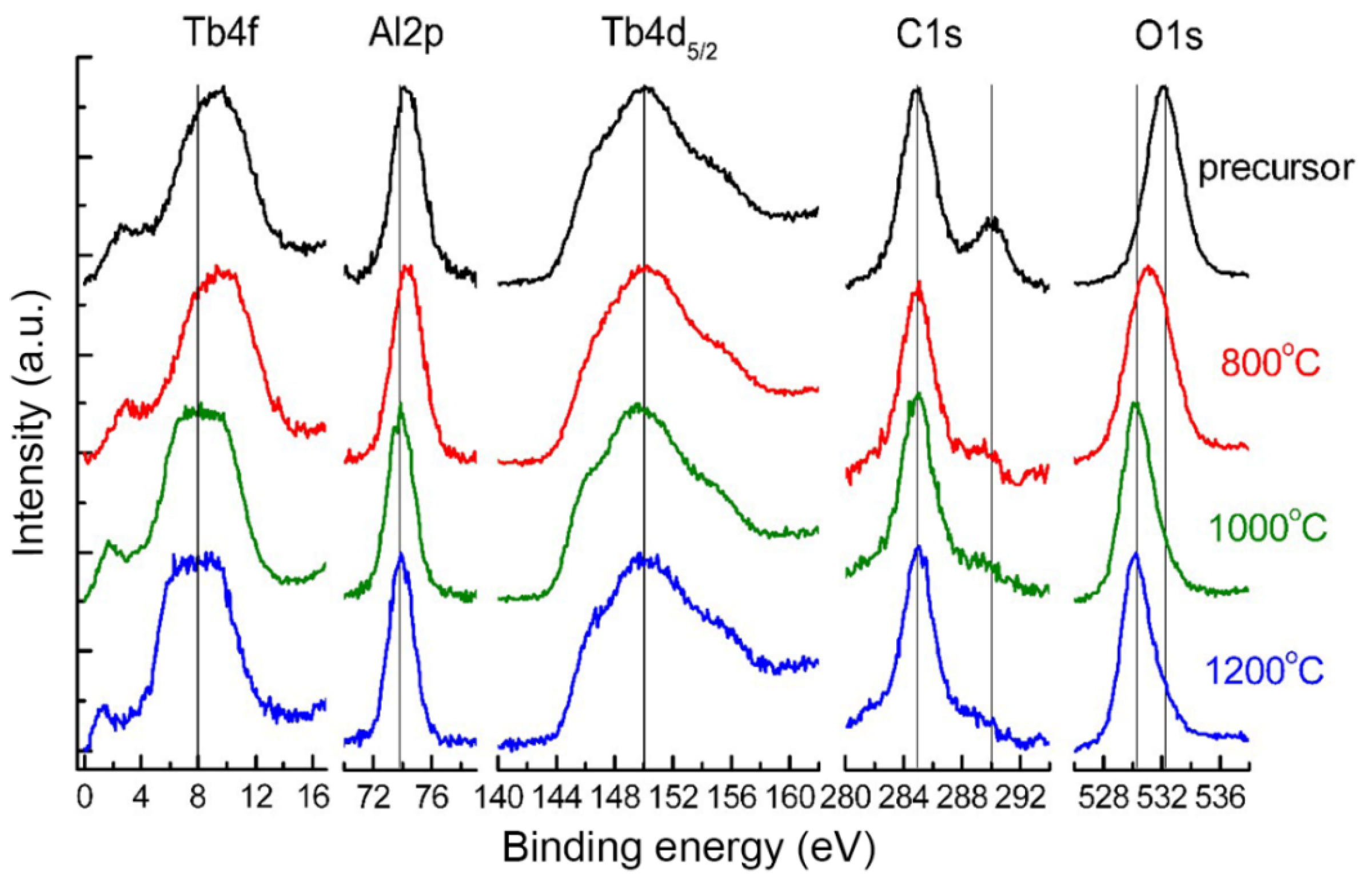

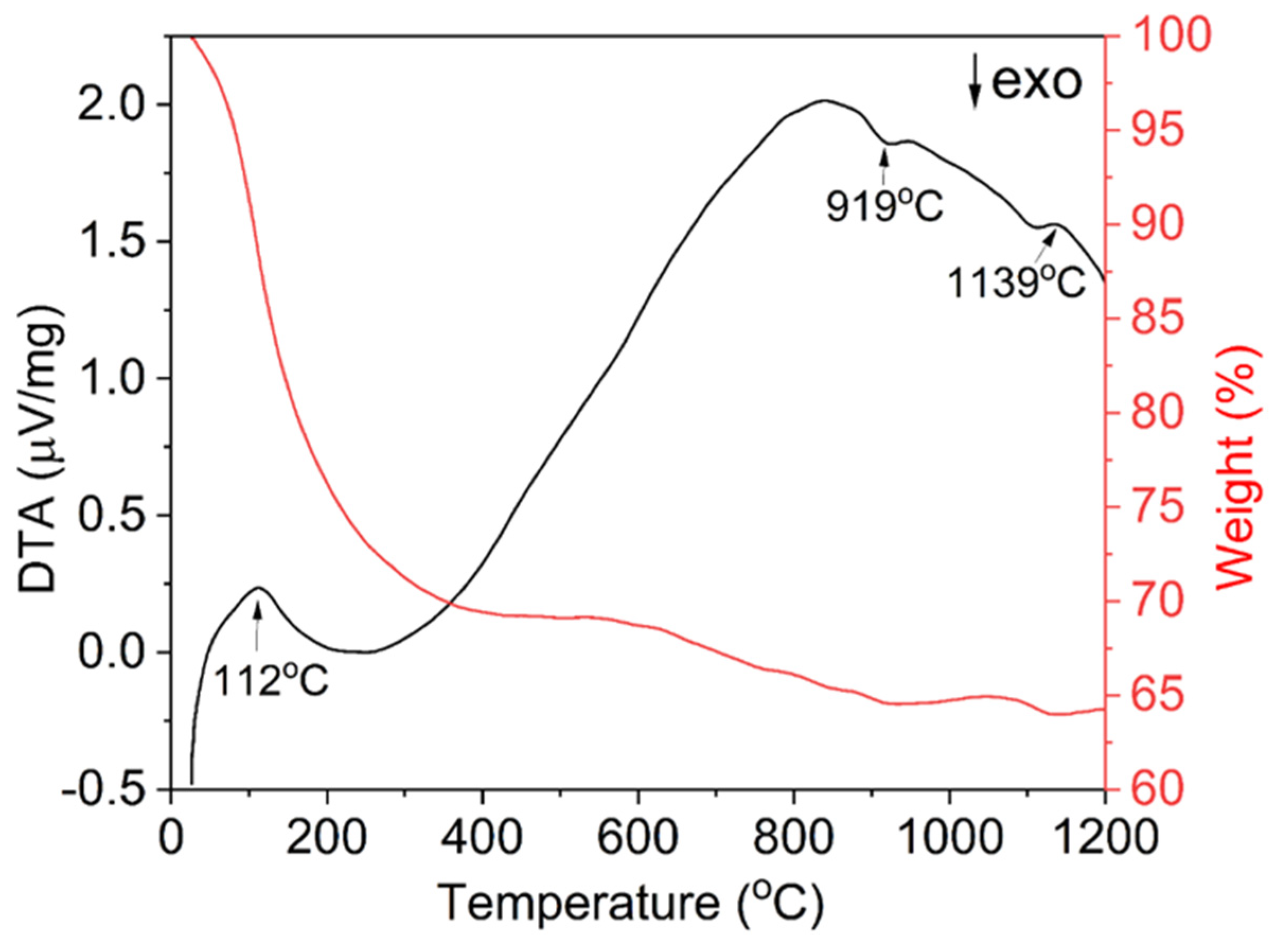
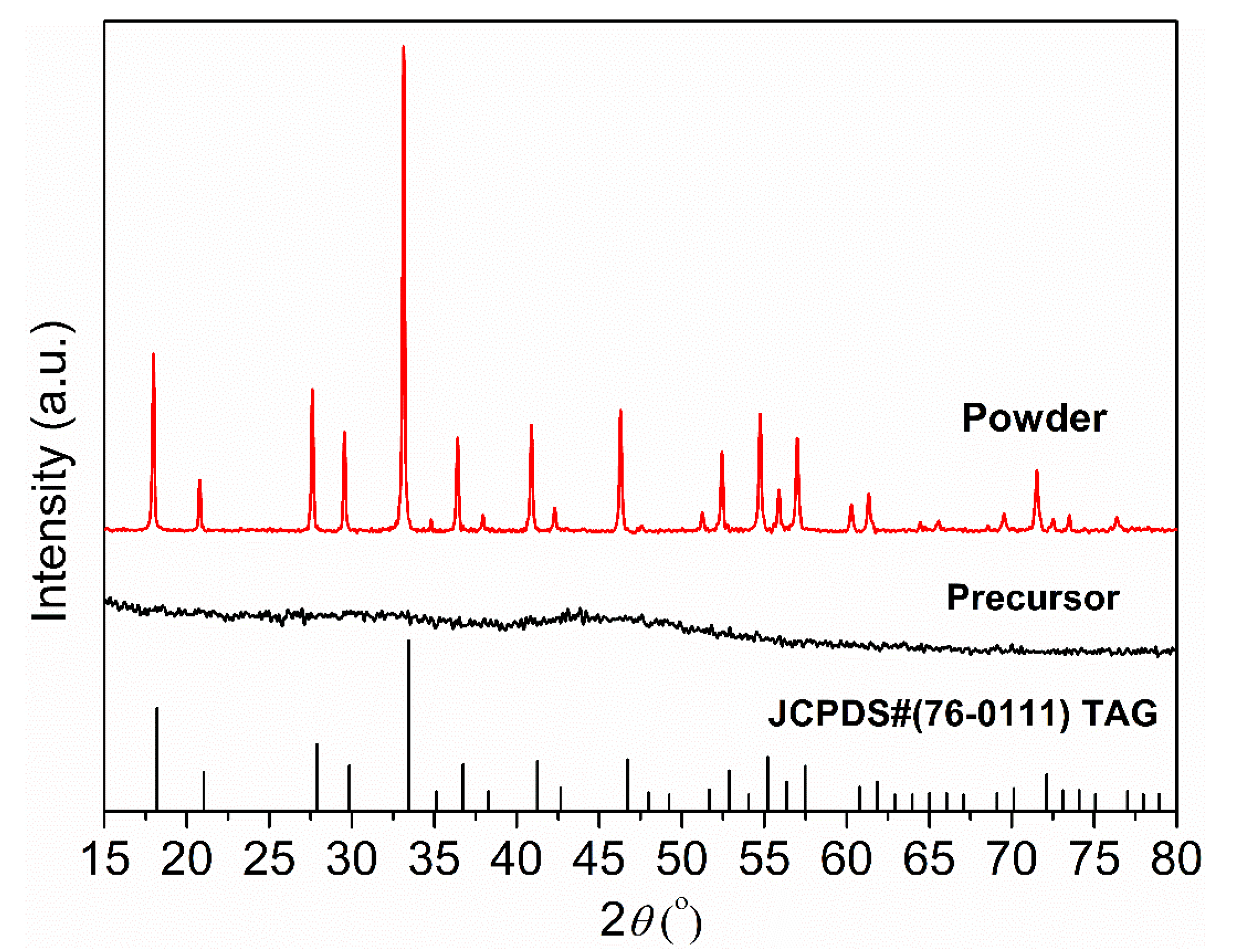
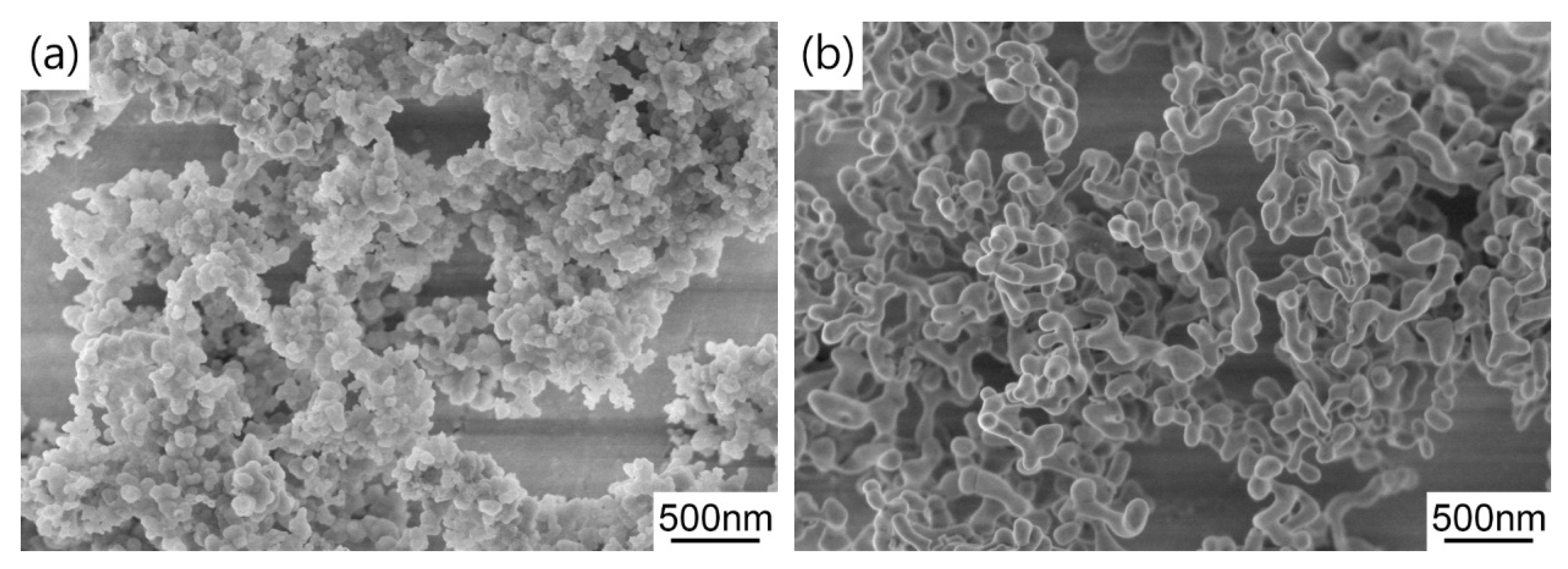

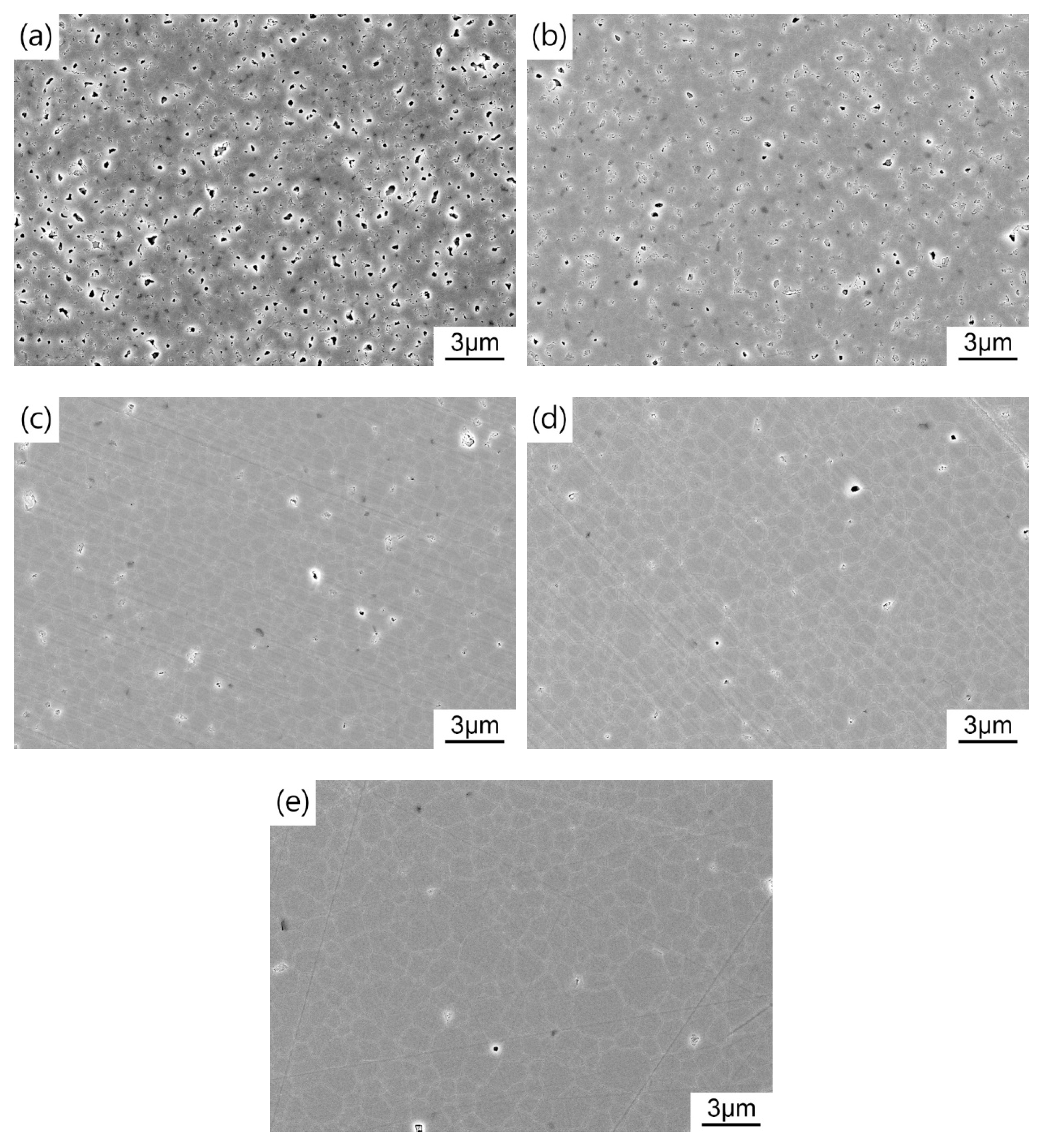
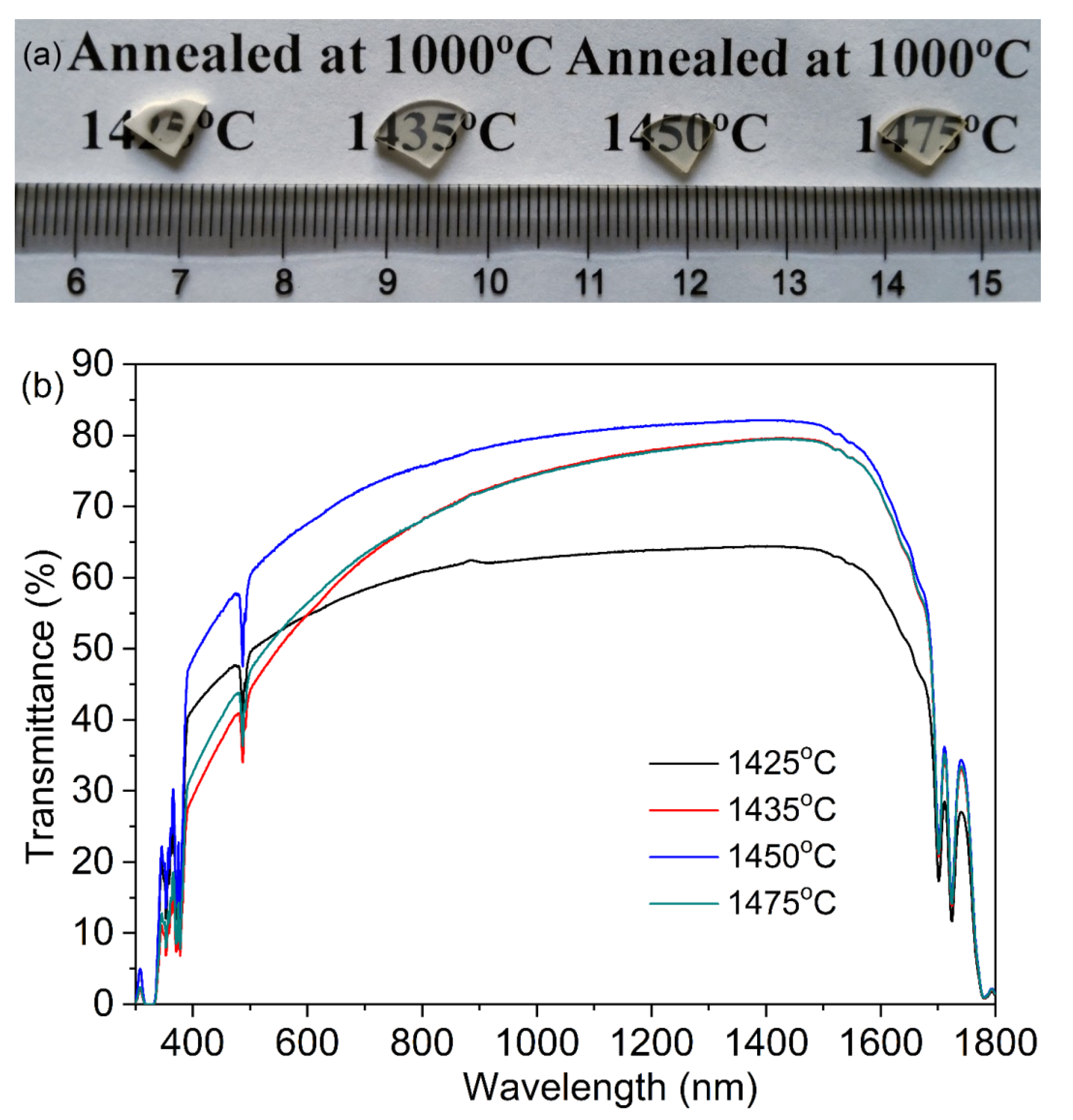
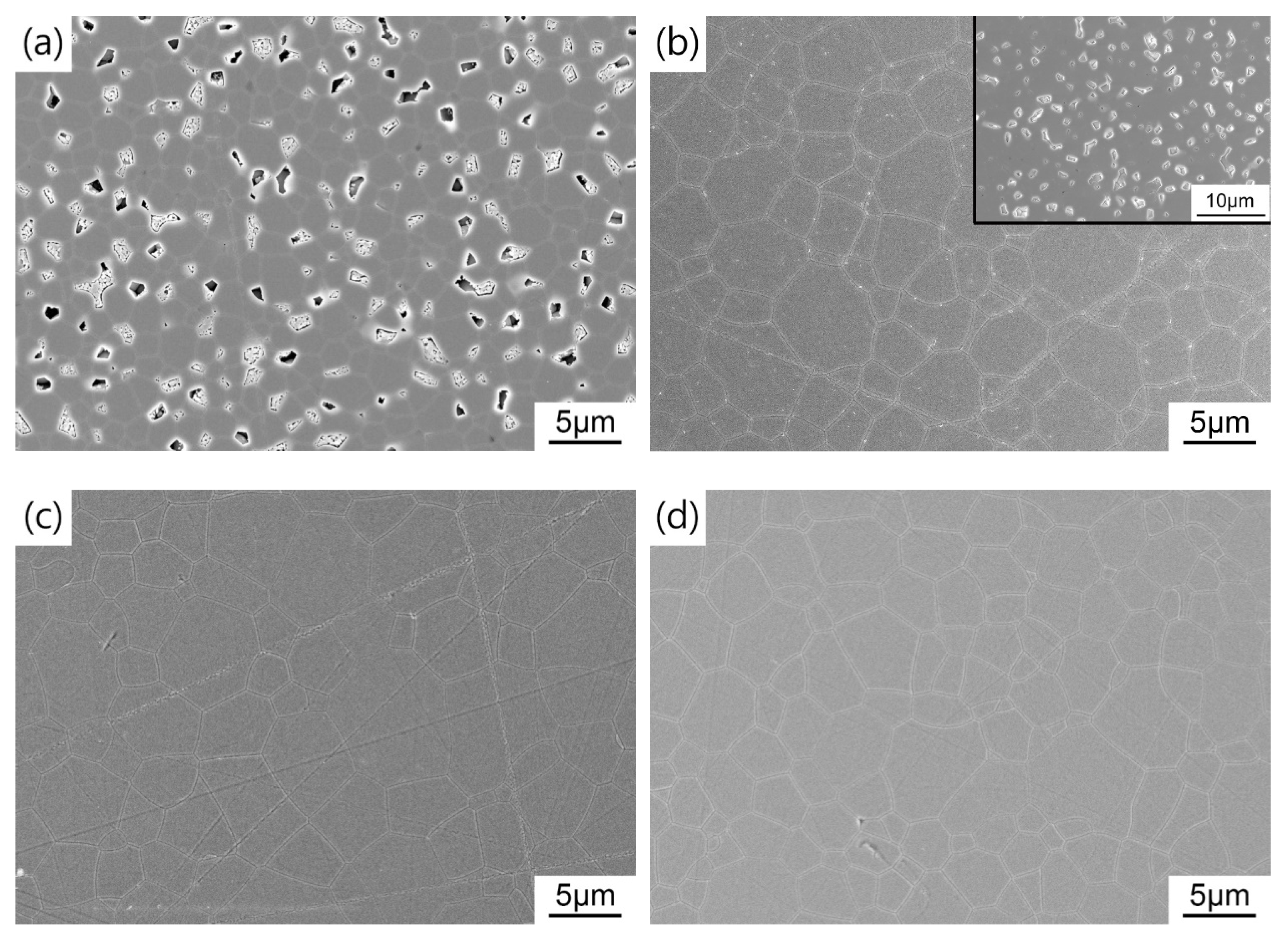
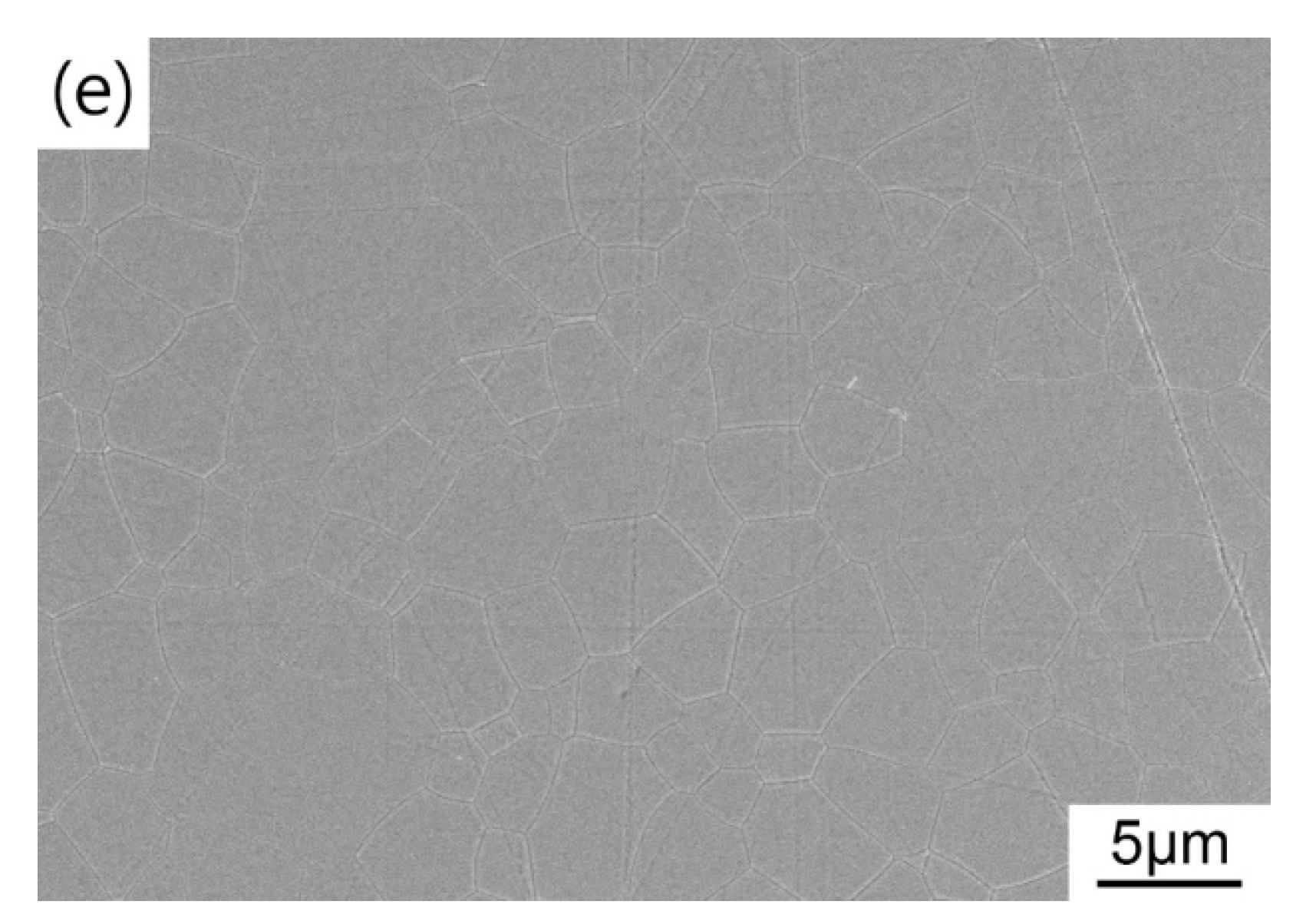
| Sample | C 1s | O 1s | Tb 4d5/2 | Tb 4f | Al 2p | |||
|---|---|---|---|---|---|---|---|---|
| precursor | Line position (eV) | 285.0 | 290.0 | 532.3 | 150.0 | 9.0 | 74.3 | |
| Chemical composition (at%) | - | 16.8 | 63.1 | 4.4 | - | 15.7 | ||
| 800 °C | Line position (eV) | 285.0 | 290.0 | 530.8 | 150.0 | 9.0 | 74.3 | |
| Chemical composition (at%) | - | 5.6 | 60.2 | 6.8 | - | 27.4 | ||
| 900 °C | Line position (eV) | 285.0 | 290.0 | 530.8 | 150.0 | 9.0 | 74.2 | |
| Chemical composition (at%) | - | 4.3 | 60.0 | 6.8 | - | 28.9 | ||
| 1000 °C | Line position (eV) | 285.0 | 290.0 | 530.4 | 532.3 | 150.0 | 8.0 | 73.9 |
| Chemical composition (at%) | - | 1.6 | 59.3 | 7.2 | - | 31.9 | ||
| 1100 °C | Line position (eV) | 285.0 | 290.0 | 530.4 | 532.3 | 150.0 | 8.0 | 73.9 |
| Chemical composition (at%) | - | 1.6 | 60.2 | 7.6 | - | 30.5 | ||
| 1200 °C | Line position (eV) | 285.0 | 290.0 | 530.4 | 532.3 | 150.0 | 8.0 | 73.9 |
| Chemical composition (at%) | - | 0 | 61.0 | 8.1 | - | 30.8 | ||
Disclaimer/Publisher’s Note: The statements, opinions and data contained in all publications are solely those of the individual author(s) and contributor(s) and not of MDPI and/or the editor(s). MDPI and/or the editor(s) disclaim responsibility for any injury to people or property resulting from any ideas, methods, instructions or products referred to in the content. |
© 2023 by the authors. Licensee MDPI, Basel, Switzerland. This article is an open access article distributed under the terms and conditions of the Creative Commons Attribution (CC BY) license (https://creativecommons.org/licenses/by/4.0/).
Share and Cite
Zhang, L.; Li, X.; Hu, D.; Dobrotvorska, M.; Yavetskiy, R.; Dai, Z.; Xie, T.; Yuan, Q.; Chen, H.; Liu, Q.; et al. Fine-Grained Tb3Al5O12 Transparent Ceramics Prepared by Co-Precipitation Synthesis and Two-Step Sintering. Magnetochemistry 2023, 9, 47. https://doi.org/10.3390/magnetochemistry9020047
Zhang L, Li X, Hu D, Dobrotvorska M, Yavetskiy R, Dai Z, Xie T, Yuan Q, Chen H, Liu Q, et al. Fine-Grained Tb3Al5O12 Transparent Ceramics Prepared by Co-Precipitation Synthesis and Two-Step Sintering. Magnetochemistry. 2023; 9(2):47. https://doi.org/10.3390/magnetochemistry9020047
Chicago/Turabian StyleZhang, Lixuan, Xiaoying Li, Dianjun Hu, Mariya Dobrotvorska, Roman Yavetskiy, Zhengfa Dai, Tengfei Xie, Qiang Yuan, Haohong Chen, Qiang Liu, and et al. 2023. "Fine-Grained Tb3Al5O12 Transparent Ceramics Prepared by Co-Precipitation Synthesis and Two-Step Sintering" Magnetochemistry 9, no. 2: 47. https://doi.org/10.3390/magnetochemistry9020047









